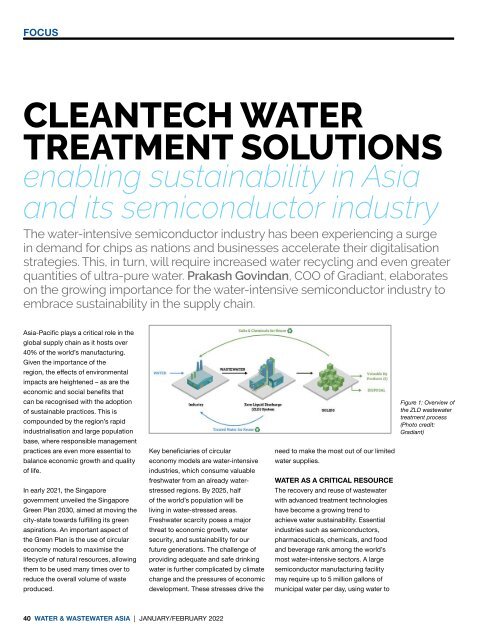Water & Wastewater Asia January/February 2022
Water & Wastewater Asia is an expert source of industry information, cementing its position as an indispensable tool for trade professionals in the water and wastewater industry. As the most reliable publication in the region, industry experts turn this premium journal for credible journalism and exclusive insight provided by fellow industry professionals. Water & Wastewater Asia incorporates the official newsletter of the Singapore Water Association (SWA).
Water & Wastewater Asia is an expert source of industry information, cementing its position as an indispensable tool for trade professionals in the water and wastewater industry. As the most reliable publication in the region, industry experts turn this premium journal for credible journalism and exclusive insight provided by fellow industry professionals. Water & Wastewater Asia incorporates the official newsletter of the Singapore Water Association (SWA).
You also want an ePaper? Increase the reach of your titles
YUMPU automatically turns print PDFs into web optimized ePapers that Google loves.
FOCUS<br />
CLEANTECH WATER<br />
TREATMENT SOLUTIONS<br />
enabling sustainability in <strong>Asia</strong><br />
and its semiconductor industry<br />
The water-intensive semiconductor industry has been experiencing a surge<br />
in demand for chips as nations and businesses accelerate their digitalisation<br />
strategies. This, in turn, will require increased water recycling and even greater<br />
quantities of ultra-pure water. Prakash Govindan, COO of Gradiant, elaborates<br />
on the growing importance for the water-intensive semiconductor industry to<br />
embrace sustainability in the supply chain.<br />
<strong>Asia</strong>-Pacific plays a critical role in the<br />
global supply chain as it hosts over<br />
40% of the world’s manufacturing.<br />
Given the importance of the<br />
region, the effects of environmental<br />
impacts are heightened – as are the<br />
economic and social benefits that<br />
can be recognised with the adoption<br />
of sustainable practices. This is<br />
compounded by the region’s rapid<br />
industrialisation and large population<br />
base, where responsible management<br />
practices are even more essential to<br />
balance economic growth and quality<br />
of life.<br />
In early 2021, the Singapore<br />
government unveiled the Singapore<br />
Green Plan 2030, aimed at moving the<br />
city-state towards fulfilling its green<br />
aspirations. An important aspect of<br />
the Green Plan is the use of circular<br />
economy models to maximise the<br />
lifecycle of natural resources, allowing<br />
them to be used many times over to<br />
reduce the overall volume of waste<br />
produced.<br />
Key beneficiaries of circular<br />
economy models are water-intensive<br />
industries, which consume valuable<br />
freshwater from an already waterstressed<br />
regions. By 2025, half<br />
of the world’s population will be<br />
living in water-stressed areas.<br />
Freshwater scarcity poses a major<br />
threat to economic growth, water<br />
security, and sustainability for our<br />
future generations. The challenge of<br />
providing adequate and safe drinking<br />
water is further complicated by climate<br />
change and the pressures of economic<br />
development. These stresses drive the<br />
need to make the most out of our limited<br />
water supplies.<br />
WATER AS A CRITICAL RESOURCE<br />
The recovery and reuse of wastewater<br />
with advanced treatment technologies<br />
have become a growing trend to<br />
achieve water sustainability. Essential<br />
industries such as semiconductors,<br />
pharmaceuticals, chemicals, and food<br />
and beverage rank among the world’s<br />
most water-intensive sectors. A large<br />
semiconductor manufacturing facility<br />
may require up to 5 million gallons of<br />
municipal water per day, using water to<br />
Figure 1: Overview of<br />
the ZLD wastewater<br />
treatment process<br />
(Photo credit:<br />
Gradiant)<br />
40 WATER & WASTEWATER ASIA | JANUARY/FEBRUARY <strong>2022</strong>


















